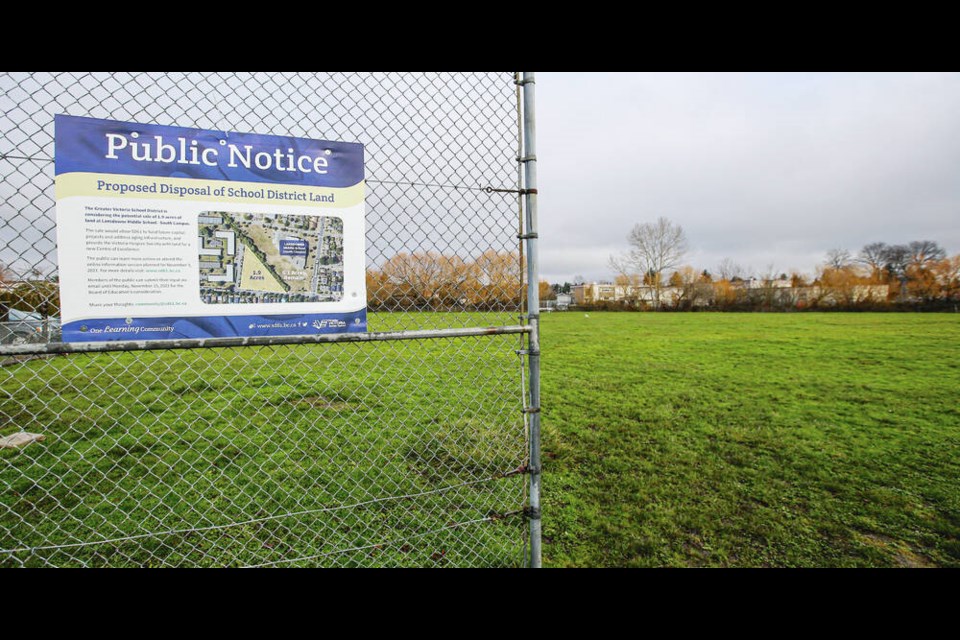For 15 years, Victoria Hospice has been searching for a site to build a modern facility.
The organization that provides end-of-life services and care for patients and their families needed a location near Royal Jubilee Hospital and the cancer unit, a place with bus stops and other health-support businesses close by. It needed the right amount of land and, ideally, in proximity to a natural environment.
Hospice finally found the perfect place for its Centre of Excellence — a 1.9-acre corner of the Lansdowne Middle School yard (formerly Richmond Elementary) dissected by Bowker Creek.
“This one ticked the boxes,” said Victoria Hospice chief executive Kevin Harter. “We’ve researched dozens of possible locations for years.”
But major hurdles stand in the way of building a three-storey, modern facility with up to 30 beds and spaces to care for the patients and train Hospice’s many volunteers and staff.
The Greater Victoria School District has to approve the sale of the land parcel, a triangular piece southwest of the school, bordering Bowker Creek.
Hospice brokered a provisional deal to buy the land from SD 61 last October for $2.5 million, and the district started a series of consultations with residents and stakeholders, including the Friends of Bowker Creek.
Proceeds from the land sale would be used for the school district’s future capital projects
The school district started three readings of a land disposal bylaw on Monday night.
If those pass, the province’s Ministry of Education must approve it, and then the municipality of Saanich would have to approve rezoning and development permits for what is generally considered an environmentally sensitive area within metres of Bowker Creek, a struggling urban waterway that flows from the University of Victoria to a beach in south Oak Bay.
Some residents are concerned a development close to the creek would harm the waterway and disrupt the creek’s natural flood plain. Heavy rains last November elevated creek levels to the point where water nearly submerged the small bridge on the site and caused torrents in the culverts at both ends of the property.
Bowker Creek goes into underground culverts near Hillside Shopping Centre and then daylights at the Lansdowne grounds before going under Richmond Road and reappearing closer to the hospital.
Harter said Hospice would work with engineering and environmental experts as well as creek stakeholders to improve the waterway as part of its overall development plan.
He said consultations are already underway on how to best improve Bowker Creek at the site, which is deeply gored and overgrown with willows and other non-native plant species.
Harter said the idea is to meander the direction of the creek with gentle bends to slow down the flow during heavy rain periods. The banks would be supported by plantings and trees to prevent erosion.
More detailed consultations with groups would also be on the horizon as a potential development proceeds, he said.
Harter said the creek is an essential part of Hospice’s Centre of Excellence as the organization believes nature is important in end-of-life care. He said Hospice would provide pathways along the creek and an outdoor classroom area that both Hospice patients and the school could enjoy.
Hospice’s design intent, he said, meets the objectives of the Bowker Creek Initiative Blue Print, which was developed to protect the waterway and is endorsed by Victoria, Saanich and Oak Bay councils.
“The riparian area habitat creation will bring the community together, including the students and area residents, with a natural environment to enjoy and learn,” said Harter.
Hospice has been operating since 1980 out of an old maternity ward at the Royal Jubilee Hospital, providing 18 beds and outpatient services for clients and families across the Island.
But it needs a change, said Victoria Hospice board member Terry Farmer.
“Our present location is in a 1940s concrete old maternity ward,” he said in a letter to the Greater Victoria School Board. “This building is extremely awkward for us as it is built like a bunker and extremely difficult to redesign to today’s standards for Hospice clients.
“It is amazing that we receive fantastic accolades from our previous clients’ families and the public. This is entirely due to our fantastic staff and volunteers who are devoted to our clients notwithstanding the very poor working conditions with the old concrete building.”
Harter said the need for Hospice services is only increasing, noting that by 2035 the population of people over the age of 75 is expected to double.
- - -
To comment on this article, write a letter to the editor: [email protected]



